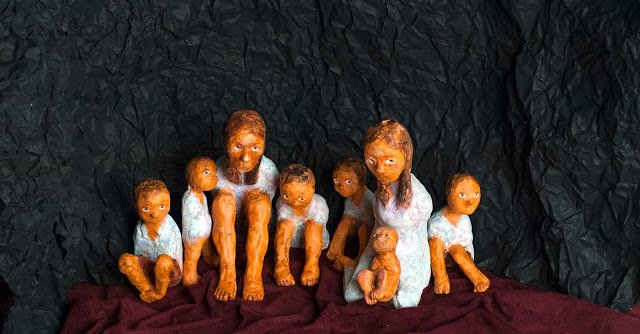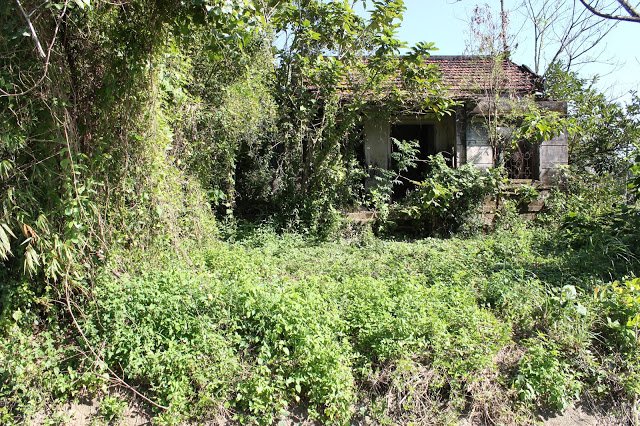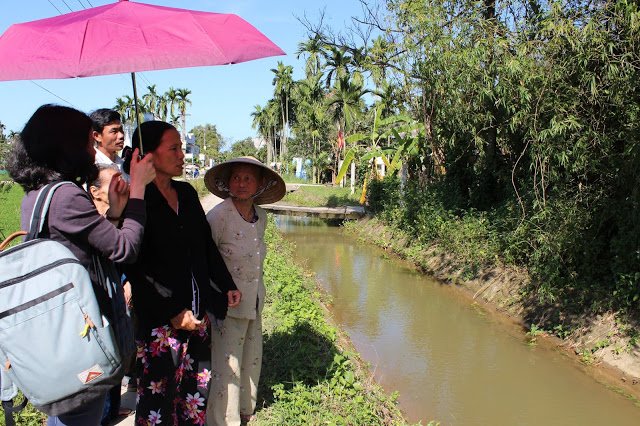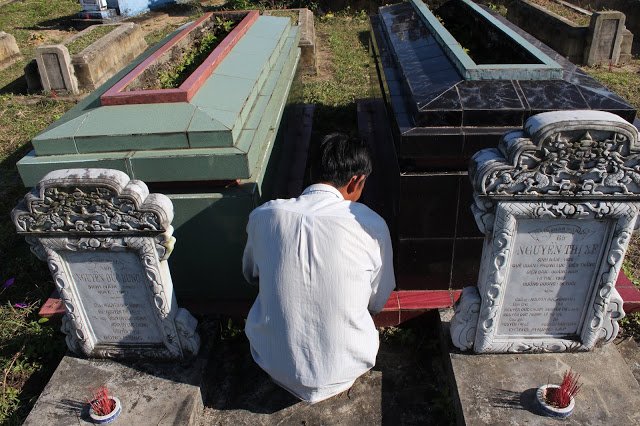
Clay sculptures of Xe and her family in their final moments. Right before they were discovered by the troops in the underground shelter. By Kim Tae-kwon; photographed by Lee Eun-kyung
Precursor to the Mỹ Lai Massacre: 1968 Phong Nhị, Phong Nhất_18: Xe, the Phantom of the Village
The tall red tiled-roof house stood out amidst the low thatched-roof homes. There was only one such house in all of Phong Lục. The best-quality wood was said to have been used in making the pillars and girders of this house that was nearly 3-4 times the size of its neighboring houses. Even the separate annex and outhouses were spacious. This luxurious house, however, was empty. There were no residents--just rats, lizards and insects that went in and out occasionally. The owners of this house left for the city two years ago in 1966 in order to escape from danger. A current of tension filled the village. The residents always lived in fear, not knowing when the now-distant sound of gunshots and explosions would rear its ugly head in their village.
February 12, 1968, 11:00am. For the first time in a while, the house was full of people, namely Xe (40), who lived next door, her children and her younger sister--all in all there were eight of them. The family, including its youngest infant member, all hid in the basement shelter of the big house. Outside, they could hear troops ransacking the entire village. Xe had just left her own home out of fear that the troops might set her thatched-roof on fire. It was a safer bet to hide in their affluent neighbor’s abandoned home. Xe knew the location of the outdoor entrance to the house’s underground shelter. It was where there was a bundle of straw, between her own house and her neighbor’s house. Xe had her family hide underground for survival because above them was a frenzy of footsteps. She tried to make sure her children don’t cry. The moment the silence inside the shelter is broken would be when they would lose in their not so friendly game of hide and seek, whereby being “it” could entail all sorts of consequences.
Xe. Her official name was Nguyễn Thị Xe. Nguyễn is the most common surname in Vietnam, just like Won (阮) is the most common name in Korea. Thị is a middle name used only for females. It originally means (氏-a reference to a person), and from the feudal age, girls were often given this generic name, instead of an original name. Xe was called Bà Xe, which meant ‘Ms. Xe,’ by the people around her. She was the woman who encountered the Korean troops in the empty house, when they left Phong Nhị and Phong Nhất and headed west before arriving at Phong Lục. The house in which she was hiding, even in March 2017, after 49 years have passed, still remains empty with dilapidated tiles and brick structures. The place looked like a haunted house, with leaves and branches rising up through the roof, and bushes so thick that they were left as they were.
The women of Phong Lục hid themselves well, that is, everyone except for Xe. Lư(37) lay prostrate and hid her body from view in the underground shelter. The troops were unable to find her. Fourteen year-old Long quickly hid herself under a bed and remained motionless for an extended period of time. The troops just passed by Long’s house, assuming nobody was home. There was a loud noise that sounded like a gunshot. The villagers slowly made their way out once it grew calm outside. There in front of the empty house were Xe and her family, fallen to the ground. 1km east of Phong Lục was the village of Phong Nhất. Another 1km east from Phong Nhất was Phong Nhị. The 2nd Brigade of the 1st Battalion of the 1st Company (Senior Commander Kim Seok-hyun) of the ROK marines had come from Phong Nhị through Phong Nhất and then to Phong Lục via the number one national highway. Phong(風) meant wind. In Vietnamese, Phong Nhất meant “first wind,” Phong Nhị meant “second wind,” and Phong Lục meant “sixth wind).

The place where Xe and her family were shot to death. A new house was built on the spot where the old house had been, but it too was abandoned by its residents. Rumors that the house is haunted is still preventing it from being sold. Photograph by Humank

The villagers testifying of Xe’s death in front of the home where she was killed. Photograph by Humank
Nobody claimed to have witnessed Xe’s final moments. There was some ambiguous hearsay, but all in all, they speculated that Xe probably made noise and gave away her family’s hiding in the underground shelter, as a result of which they were all dragged out to the front of the house and shot to death. Xe was soft-spoken, sweet and innocent. She was about 150cm tall and lean. She was such a hard worker that immediately the day after she gave birth, she went out into the fields to catch freshwater snails. Nonetheless, there was something off about her. Not having even graduated from elementary school, she was illiterate. Nobody would say she was sharp. They covered the eight bodies with mats. They had no other relatives in the village. They had to wait until Xe’s husband, Bồng, came home.
Bồng worked 30 some kilometers away in the city of Da Nang, as a farmhand of another household. His family, for generations, had been farmhands. All of his brothers were also farmhands. Like his wife, Bồng was a kind and even-tempered man. Xe worked as a housemaid before she got married. They were both at an appropriate age for marriage. The villagers gossiped among themselves saying that they were perfect for each other, given their backgrounds and occupations. Bồng and Xe had many children; four boys: Luôn(born 1954), Ben(9), Cu(2), and Bủng(1), and three girls Ngot(11), Be(8), and Bê(7). Their eldest son Luôn died in 1963 from stepping on a booby trap while he was herding cattle. The rest of their children died with their mother and aunt on February 12, 1968. They were annihilated all at once.
Xe was buried in the field next to the ridges between the rice paddies. Bồng dug the graves for his wife, her younger sister, and their children. The corpses were not all intact. They were tattered as if shot by a machine gun. It was in fact hard to tell whose body belonged to whom, with limbs missing and corpses flung over trees. Using chopsticks, Bồng peeled off the pieces of flesh stuck on the trees. The only one whose corpse wasn’t mutilated was their infant child, Bủng. Bồng wrapped Bủng’s body with a mat and buried him separately. As for the rest of the family, Bồng had to gather what remained of their corpses and bury them one by one--all seven of them. There were eight corpses in total, but he only used two graves. In all of Phong Lục, there were 10 victims. Phong Lục was divided into north Phong Lục and south Phong Lục. There were two victims from north Phong Lục, and eight in south Phong Lục, which were Xe and her family.
The tall tile-roofed house in Phong Lục collapsed, much like Xe who was discovered in its underground shelter. It happened sometime in 1970. Though unclear which army was responsible for it, the house had been bombarded. Nothing was left at the site where the house had been built, until a resident named Ông Do decided to build another house there. It was in 1975, immediately after the fall of the South Vietnamese government and the socialist regime’s rise to power. Ông Do used to live in the home of his paternal grandfather’s younger brother in Phong Lục until his grandfather’s family, who, according to the 1954 Geneva Convention(as a result of which North and South Vietnamese people had to reside in their respective part of the country), had migrated north, returned to the village in 1975, and Ông Do had to find a new home. Ông Do cleared the land where the tile-roofed house had been and raised a new building. He made a garden for flowers and vegetables too. No longer was there such a thing as land ownership, which used to exist under capitalism up until 1975. Consequently, when Cảnh, the previous owner of the site returned later and insisted that Ông Do sell the new house to him, Ông Do refused.

Xe and her five children resting in the public cemetery in Phong Lục. Buried together, along with Xe’s younger sister (right), with only Bung with his own grave. Cung, the son of Xe’s husband Bồng from his second marriage is taking care of the graves. They were originally buried in the empty field next to the ridges of the rice paddies but were moved here in 1987, and in 2010, the monument was raised to commemorate them. Photograph by Humank
Ông Do didn’t feel at ease however. When he built the new house, an unsettling rumor was circulating in the village, that the resentful spirits of those who were killed in the house still haunted the site. The rumor was what had become of the unfortunate story of Xe and her family. Even after they built their new home, Ông Do’s family was still struggling with poverty and was hardly ever harmonious. Ông Do sometimes wondered if that was because they were cursed by the spirit of the deceased. In 1990, when Ông Do’s older brother passed away, Ông Do immediately moved into his brother’s house. During the span of fifteen years, the house was abandoned twice; once during war, and again during peacetime.
Bồng got remarried, but he still lived a life of poverty. His new wife, Được(born 1923), gave birth to four children. Their youngest daughter died at an early age, and only Le (born 1971), Chung(born 1976), and Cung(born 1978) remained. Le was three years younger than Xe’s infant son, Bủng. In 1987, when Le turned 16 years old, he visited Xe’s grave with his father in order to move them to a public cemetery. They began digging the graves that were next to the ridges of the rice paddies, which were teeming with freshwater catfish. Le was so shocked from the sight that he was never again able to eat anything with catfish in it. The mats with which Bồng had wrapped them had decomposed, and the corpses, further disfigured, wandered afloat. Even at the public cemetery, Bồng used one grave for Bủng and another for the rest of his family members.
Bồng passed away in 1992. His second wife, Được, also passed away in 2009. Le always felt unsettled at the thought of the graves of his father’s former family. Even the new grave at the public cemetery was shabby. No matter how poor they were, the people of Vietnam spared no money on appeasing the spirit of the deceased--it is a social and cultural custom. His father’s first wife was no exception to this custom. Le along with his siblings agreed to place a proper tombstone and properly groom the graves of his father’s former family. This was in 2010.
Ông Do also passed away in the mid 2000s, whereupon his son, Đáp(born 1960) inherited the 60㎡ house. Đáp later passed the ownership down to his second son, Phái(born 1994). Đáp had previously attempted but failed to sell the house through a realtor. He too knew why this house was difficult to sell, even with professional help. It was because of the rumors about Xe’s phantom. The house has remained empty for 28 years since Ông Do moved into the home of his older brother. The time that this house had been abandoned in ruins during the war was only nine years. But even after the war ended, the house endured 28 years of not being occupied, a period three times as long as that during the war. The villagers would conjure up the tragic fate of Xe whenever they looked at the house. It was as if Xe alone had remained continually in the house for 50 years, roaming about the village of Phong Lục.
Xe. The name was etched on a monument that was raised in Phong Nhị and Phong Nhất to remember the massacre. However, Phong Lục was never included or mentioned when retelling the events of that day, as the U.S., when investigating the survivors and families of victims, was unaware of the village’s existence. It wasn’t until the mid-1990s when the Dien Banh office of culture and communications recorded the incident that the victims from Phong Lục were also registered on the list. Xe is number 36 of the 74 victims. ‘36 Nguyễn Thị Xe, 1936, Phong Lục-Điện Thấng.’ Present-day Phong Lục is a part of Nam Điện Thấng. The names of Xe’s five children and younger sister are also on the monument (with the exception of Bủng). They are numbers 48, 51, 59, 70, and 38.
The road to the monument is lined with dense rows of betel palm trees. The fruit of the betel is a small but traditional wedding gift in Vietnam. Xe too had a moment in time when she received this gift as a young woman of 25. When Xe and Bồng got married in the spring of 1953, Vietnam was still colonized by the French. As per their lowly social statuses, they two could not afford proper wedding attire. Instead, they wrapped themselves with inexpensive cloth and were barefooted. Bồng took a bottle of trầucau rice wine to Xe’s home, according to customs. Associated with this wine was a tragic legendary love story about two brothers who fell in love with the same woman. When you combine betel leaves with its fruit, add lime and then chew it together, at first it tastes spicy and bitter but eventually becomes sweet. It would make your saliva red, which symbolized the the passion between married couples. After extending the trầucau rice wine to Xe’s family, he brought her home to be his wife. Time flew by, and in no time, Xe was in her forties, hiding in the basement shelter of the empty house with her children. Could she really be living as a ghost in the empty house to this day, looming about the village? She didn’t even so much know who the troops were, and why they had invaded her village and taken her life, along with those of her family members.

(from the left)Nguyến Thị Lư, Nguyễn Thị Nhì, and Trần Thị Long, Xe’s old neighbors look around the home that Xe and her family used to occupy up until 1968. Xe’s house is located right next to the home in whose basement she was hiding. Photograph by Humank
The Incident of Phong Nhị, Phong Nhất and Phong Lục
It all began with my wondering why Xe, who was from Phong Lục, was included on the list of victims from Phong Nhị and Phong Nhất. I extensively collected material from Phong Nhị and Phong Nhất since 2000. I visited the villages multiple times to interview survivors, witnesses, and families of victims, and I had thought I had covered all there was to cover, but there still remained a question mark.
In 2016, as I was looking through the Điện An town People’s committee list of those who were killed or injured during the incident, the addresses listed next to some of the names caught my eye. Many of them weren’t from Phong Nhị or Phong Nhất, where the incident had taken place. Including Xe, there were 12 people whose addresses were in Phong Lục. If we included Xã Điện Phước Xa La Hòa, Nông sơn, and Xã Điện Hòa La Thọ, there were 20 people who wasn’t originally from Phong Nhị and Phong Nhất. Curious as to how they could have ended up dead in a completely irrelevant village, I began investigating in February of 2017.
The rural communities in central Vietnam were more cohesive than in Korea. Descendents of inhabitants from forty-nine years ago still resided in the area. I was able to locate the people on the list with the help of each town’s People's Committee. I listened to about 90% of victims' stories and testimony regarding their final moments, and was able to confirm the following three facts.
First, the Phong Nhị and Phong Nhất Massacre should be renamed to include Phong Lục. This was the first time that it was made known that the 2nd brigade, 1st battalion, 1st company of the ROK marines killed civilians in Phong Lục as well.
Even according to the records in <Korean Warriors dispatched to Vietnam>, published by the Ministry of National Defense, the marines are reported to have moved westward from Phong Nhất. Ryu Jin-seong (born 1946), who entered the Phong Nhị as a member of the 1st squadron's 2nd platoon, also testified in an interview in June 2018 saying, "I remember that after I went to Phong Nhị, we went farther west to execute our strategy.”This place was likely Phong Lục. It is definitely fewer than in Phong Nhị and Phong Nhất, but the number of victims is over 10.
Second, victims from parts other than Phong Lục were killed as they were passing through Phong Nhị and Phong Nhất on their ways to and from Da Nang. It was as I had expected before embarking on this investigation. There were those who were involved in Viet Cong activities, but even so, they were all women or the elderly.
Third, the survivors and families of victims in Phong Lục and the rest of the area reacted as if they were seeing a Korean for the first time in 49 years since the incident. When the Phong Nhị and Phong Nhất incident was made known to the Korean public for the first time, a civic group called, “Me and We”
collected donations from the people and set up a memorial at the entrance of Phong Nhị in 2004. Every year, when it gets close to the date of the incident, more than 10 civic groups have been sending flowers to the site of the memorial. Phong Lục had fallen under the radar when the Korean people actively tried to reconcile and address past issues with Vietnam.
- Written by humank (Journalist; Seoul, Korea)
- Translated and revised as necessary by April Kim (Tokyo, Japan)
The numbers in parentheses indicate the respective ages of the people at the time in 1968.
This series will be uploaded on Steemit biweekly.
기사 잘 읽었어요. 영어로도 읽고픈데 지금은 엄두가 안 나지만 나중에 시도해볼게요.
Downvoting a post can decrease pending rewards and make it less visible. Common reasons:
Submit
지금 댓글 봤네. 고마워. 스팀잇은 여전히 열심히 올리더군.
Downvoting a post can decrease pending rewards and make it less visible. Common reasons:
Submit